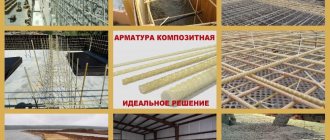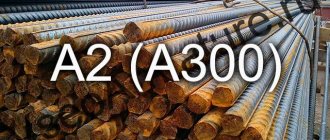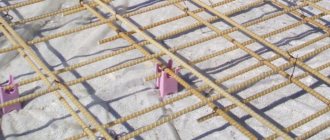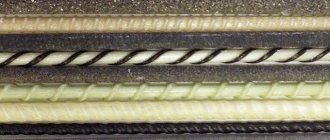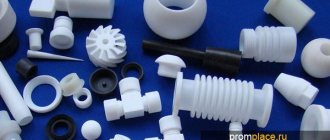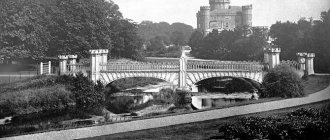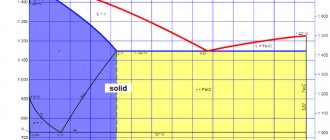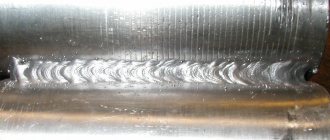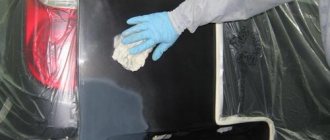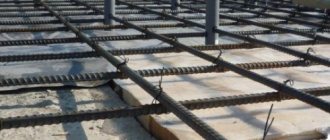Metal reinforcement is considered a reliable option for forming the “skeleton” of monolithic concrete. And today its importance and necessity in construction is not in doubt, although a new type of reinforcement has appeared on the market and is steadily progressing - composite or fiberglass (FRP). The material can be called “new” quite conditionally; it came to the market 50 years ago. For Russia, fiberglass was irrelevant until recently; we have enough resources to produce our own metal at a reasonable price for construction.
At the same time, fiberglass reinforcement has caught up and surpassed metal in a number of properties, and conclusions about the strength and durability of the material can be drawn from global experience in operating spas.
Structure of composite reinforcement
A building material is made from fiberglass fiber impregnated with a polymer binder in the form of relief rods of a given size - fiberglass reinforcement. Material structure:
- Inner rod. Serves to provide basic functional characteristics. Fiberglass fibers are used in production. They are placed in the structure of the rods in parallel or in the form of braided weaving, then filled with polymer resin.
- External covering. It is performed by winding composite fibers onto an internal rod or by spraying a fine abrasive onto it.
Diameter of plastic fittings
Due to certain design features, fiberglass reinforcement has several parameters that characterize its diameter:
- The size of the outer diameter of the composite rod is determined according to the location of the ribs protruding along the profile;
- Inner diameter refers specifically to the rod itself;
- The nominal diameter refers to the digital designation of a specific profile.
All these parameters do not coincide with each other. The nominal diameter is smaller than the external diameter, measured by the protruding ribs. You should pay special attention to these parameters. This will help you avoid purchasing smaller reinforcing rods than necessary.
There are some nuances in determining these sizes of fiberglass reinforcement. The outer diameter of the product is determined in the same way as for steel. As for the internal diameter, it is more difficult to determine due to the non-perfectly round cross-section of the rod.
Standard sizes and parameters
The diameter of the produced spa varies in the range of 4 – 18 mm. Products are produced in the form of measuring rods or in coils.
The total length of the reinforcement in the coil depends on the technological equipment used in its manufacture. Spas with a diameter of 12 mm or more are offered to the consumer exclusively in the form of rods.
The main parameters affecting the scope of application include the weight of one meter and the diameter of the composite rod.
The winding pitch can be considered an additional characteristic, but today almost all manufacturers produce reinforcement with a pitch of 15 mm.
Physical parameters of fiberglass reinforcement material
According to today's requirements, composite rods must be characterized by three main physical parameters, namely:
- Mass of elements;
- Winding distance;
- External as well as internal diameter.
Each individual profile number has its own physical indicators. The only constant parameter is the winding distance, equal to 15 millimeters. The current specifications regulate that composite rods differing in profile size have the following digital designations: 4, 5, 5.5, 6, 7, 8, 10, 12, 14, 16 and 18. These digital values correspond to the outer diameter parameters. The mass of reinforcing rods can vary from 0.02 to 0.42 kg/1 running meter.
Areas of application
Due to the demand for fiberglass reinforcement in construction, manufacturers began to offer products not only in the traditional version - coils and rods. Fiberglass reinforcing meshes and ready-made reinforced frames have appeared on the market in various designs in shape and dimensional parameters.
Composite reinforcement is used in a number of construction works and the manufacture of building structures:
- Reinforcement of structures made of monolithic concrete: walls, wells, coatings, foundations.
- Strengthening masonry made of piece wall materials - brick, stone, as well as porous and lightweight blocks of all types.
- In the construction of road surfaces and strengthening of embankments.
- Construction of buildings using permanent formwork technologies.
- Providing flexible connections of load-bearing, facing, reinforcing layers in the construction of multi-layer walls and other structures.
- Manufacturing of power transmission line supports and railway sleepers.
- Use as dowels for fastening thermal insulation of buildings.
- Installation of utilities, sewerage, drainage.
- Creation of reclamation systems.
- Composite products have gained particular popularity among summer residents and owners of personal plots. SPA is used on the arcs of greenhouses, to create decorative and economic fencing, and to support fruit trees.
Strip foundations
Reinforcement of a strip foundation using fiberglass reinforcement occurs by replacing metal reinforcement with fiberglass reinforcement according to the equal-strength replacement table.
Table of equal replacement of metal reinforcement with composite fiberglass reinforcement
| Metal class A-III (A400C) | Composite polymer fiberglass reinforcement OZKM (AKS) |
| 6 A-III | 4 AKS |
| 8 A-III | 5.5 AKS |
| 10 A-III | 6 AKS |
| 12 A-III | 8 AKS |
| 14 A-III | 10 AKS |
| 16 A-III | 12 AKS |
| 18 A-III | 14 AKS |
| 20 A-III | 16 AKS |
Correct, equal-strength replacement of metal reinforcement with fiberglass will allow you to receive economic benefits of up to 45%
(savings 2 times).
When replacing metal reinforcement with fiberglass, there is no need to increase the number of layers of reinforcement and the number of rods in one layer.
If it is necessary to lengthen the fiberglass reinforcement rod, the connection occurs in an overlap. The length of the overlap is from 20 to 50 cm.
Knitting of fiberglass reinforcement is also carried out using a knitting wire; cutting of fiberglass reinforcement is carried out with a “grinder”.
Ribbed and smooth rods
The ribbed profile of the products is necessary to improve adhesion to the concrete mixture. Sometimes, for the same purpose, the surface of the reinforcement is sprinkled with sand during the hardening process.
Fiberglass rods with a smooth surface cannot have proper adhesion to concrete, which is why they are less in demand as reinforcement for concrete work.
But the price of smooth rods is much lower, so it makes sense to use them as auxiliary products with minimal load when assembling a frame for reinforcement.
Strengthening foundation structures.
When used to reinforce strip and other types of fiberglass foundations, rods with a diameter of 8 mm are used, which is equivalent to the use of 12 mm steel reinforcement.
Fiberglass reinforcement properties application.
Calculations for replacing steel reinforcement with fiberglass.
It is not difficult to carry out the procedure for such reinforcement with your own hands, if you adhere to the following algorithm.
- When installing the formwork, it is recommended to wrap its elements with parchment, which will allow them to be reused.
- On the inside of the formwork elements, using a horizontal level, mark the line up to which the concrete solution will be poured. This procedure will allow the concrete solution to be more evenly distributed throughout the entire internal volume of the future strip or any other foundation.
- The reinforcement elements with which you will strengthen your foundation must be covered with a layer of mortar at least 5 cm thick. In order to maintain this distance, you can use ordinary bricks that are laid on the bottom of the future foundation.
- Two rows of reinforcement are placed on the bricks laid at the bottom of the future foundation. In this case, it is desirable that solid rods be used, without joints. By measuring the length of the sides of the foundation being poured, you can easily determine how long the rod you will need to unwind and cut from the overall coil.
- After laying the longitudinal reinforcement bars, it is necessary to attach transverse jumpers to them, which are fixed with plastic clamps.
- Then you need to make the upper level of the reinforcement cage, which should be identical to the lower one. Both levels of such a frame, the cell dimensions of which should be approximately 150 mm, are connected using vertical jumpers.
- After making the reinforcement frame, they begin pouring the concrete solution. It is up to you to decide what concrete mixture will be used for this, but preference is most often given to the M400 brand solution.
Fiberglass reinforcement, application features.
Reinforcement of the foundation belt with fiberglass reinforcement.
Fiberglass reinforcement used in construction.
To quickly and continuously pour the foundation, it is better to use the services of a mixer
It is not difficult to calculate how much mortar you will need to fill the foundation: to do this, you need to calculate the perimeter of the future foundation, and then multiply the result by its width and depth. When pouring concrete mortar with your own hands, it is important not to forget that it must be compacted periodically so that air bubbles do not form in the foundation mass.
It will take 2-3 weeks for the poured concrete solution to completely harden. During this period, the poured foundation must be covered with a film from rain, and if the weather is hot outside, its surface must be periodically moistened with water.
Reinforcement made from fiberglass is a relatively new material on the domestic construction market that has not yet stood the test of time. Therefore, when using such material to reinforce concrete structures, you must understand the extent of responsibility for your choice.
Advantages of composite reinforcement
Thanks to the combination of non-metallic fibers and a binder composite composition, fiberglass reinforcement has acquired additional qualities and properties that are actively used in practice:
- low specific weight, which reduces transportation costs and facilitates installation;
- no welding operations required;
- tensile strength, almost twice that of metal;
- chemical resistance;
- low level of thermal conductivity combined with a wide operating temperature range;
- high dielectric constant.
The advantages of the material itself are complemented by the features of the technological process:
- all core threads are equally stressed, which enhances the strength of the spa;
- the thread flow at the twisting stage is cleared of all kinds of contaminants, which ensures optimal consumption of components during production and helps reduce the final cost of products;
- To increase chemical resistance and enhance adhesion to concrete, the reinforcement is coated with a layer of vinyl ester resin.
Construction technology.
To build a strip foundation, precise calculations and a specific action plan are used. To begin with, dig a trench 30-80 cm in length. Its dimensions are calculated from the necessary measurement data, weight and area of the future structure.
Then, depending on the type of land, conditions and overall mass, the filling depth is calculated. The usual standard depth ranges from 60-80 cm, but with individual calculations, the depth of the strip foundation can be completely different.
A kind of cushion layer is created with the addition of gravel, which will improve installation. It needs to be watered very heavily. Fiberglass reinforcement is created for a strip foundation with an area of 10 mm. Its installation takes place on bricks or other possible supports with the expectation that 5-10 cm remains from the bottom.
The initial rods are mounted with a registration and program distance from the walls of the pit of 10 cm, then the vertical and transverse posts are tightly secured at an equal interval of 40 cm. The first two upper rods of reinforcement are fixed on them and tied together with transverse rods.
Fiberglass reinforcement.
Types of fiberglass reinforcement.
The form (formwork) of the foundation is made. To do this, take an edged board 25 mm wide and knock together rectangles of the required size (taking into account the measurements of the foundation), which should be about 30 cm above the ground level. After this, a box is assembled from the prepared rectangles and installed in place of the foundation, Place spacer bars and sprinkle the soil.
The finished form is filled with concrete. If support pillars were used, they must be mounted and precisely aligned with the concrete pouring level. This is all done based on calculations and data obtained.
Recommendations for choosing products
Criteria for selecting a spa for construction work:
- compliance of the product diameter with the declared values;
- quality of winding of the outer layer;
- Availability of quality certificates and material test reports.
If after a visual inspection it turns out that the color of the fittings is darker than that declared by the manufacturer, then it is not recommended to purchase such products. Darkening of the spa means a violation of the temperature conditions during manufacturing, the product is considered burnt, and its technical characteristics do not correspond to the declared ones.
To sum it up.
As can be seen from the list, making a strip foundation on fiberglass reinforcement is not difficult and does not require special knowledge. Having understood what fiberglass reinforcement is, everyone can significantly reduce their time and money for installing a box and at the same time benefit from the quality and strength of the material.
The only condition is that the construction be carried out in stages. Each stage should begin after the previous one is completely completed. When installing a foundation, calculations of depth and thickness are very important, and software calculations on a computer help with this. By calculating future data in this way, you can significantly reduce the time spent on unnecessary measurements and unnecessary consumption of materials.
The choice of materials for installation and manufacturing also plays a significant role. It is worth giving preference to high-quality, certified material and components when receiving it. Using good material and accurately following the action plan is the key to obtaining a reliable foundation in the future.
It is worth noting that the entire building and its future condition will directly depend on the correctness of the foundation, since it is the main support for the future building and its installation should be taken as seriously as possible.
Comparison of the characteristics of steel and fiberglass reinforcement
You should not compare and evaluate steel and composite reinforcement, dividing it into “good” or “bad” based on a set of characteristics. There are precise definitions of when fiberglass reinforcement should not be used, and when it may be the best solution.
As a rule, the justification for any choice is the technical characteristics of fiberglass reinforcement and its metal competitor.
Comparison of these types of fittings is inevitable, since they have similar parameters and areas of application, which means they can be mutually replaced if certain conditions are met.
Concrete areas for driving and parking.
Before reinforcement begins, a 5 cm layer of crushed stone is poured on top of the concrete pad onto the sand cushion and compacted. Fiberglass reinforcement strengthens the concrete structure, so when constructing a parking lot you cannot do without it. Concreting of the area for driving and parking a car is carried out using fiberglass reinforcement, which is cut into rods of the required length. It is recommended to use fiberglass reinforcement with diameter F6.
The reinforcement frame is made directly at the installation site and does not take much time. Fiberglass rods are placed crosswise and tied with wire at the joining points.
Flaws
The popularity of fiberglass reinforcement is justified by a number of undoubted advantages, but the material also has disadvantages that can cancel out all the advantages.
Low modulus of elasticity
This indicator means that composite products should not be used to reinforce monolithic floors or sections thereof. If it is absolutely necessary to use SPA, it is necessary to carry out careful technical calculations.
Low thermal stability
Fiberglass reinforcement is a self-extinguishing material that cannot spread fire in concrete structures. But at high temperatures, spa products sharply lose their functional strength characteristics, which limits the scope of application of composite reinforcement.
Loss of strength
Fiberglass reinforcement reduces or loses its strength characteristics over time (polymer organic bonds are destroyed - the so-called “aging” process of organics). The process is accelerated when the reinforcement is exposed to alkaline environments. To avoid this drawback, composite products with the addition of rare earth metals should be used.
Taking into account all the listed, even unique advantages of fiberglass reinforcement rods, their use is allowed only in conditions and structures where the material will not experience destructive loads and impacts.
Conclusions and recommendations
Taking into account the price factor (a composite of equal strength to steel will cost more), we cannot recommend composite reinforcement for widespread use in private construction.
For the reinforcement of crossbars, floor slabs, load-bearing beams, columns and stiffening diaphragms, experts strongly advise against installing it. Such reinforcement can be used as structural reinforcement. It can be used to reinforce slab foundations.
Slab foundation with a frame made of fiberglass reinforcement
To strengthen pile grillages and strip foundations, it is better to buy steel rods.
Nuances and features
As with any relatively new building material, there are many conflicting opinions about SPA in professional and amateur circles. Let's try to understand the authenticity and validity of some judgments.
About SPA bending
The need to bend reinforcement often arises during construction, directly on site. But fiberglass rods cannot be bent efficiently directly at the installation site - this is what distinguishes it from metal. Builders often consider this a disadvantage of the spa, but not critical. There are two acceptable solutions:
- Bent elements are ordered from the manufacturer in advance if there is a reinforcement design or at least an understanding of the need for bending.
- It is possible to use mixed reinforcement. In this case, composite rods are connected to corner elements made of metal reinforcement.
About the regulatory framework for the use of spas
Opponents of fiberglass reinforcement in construction argue that its use on construction sites is illegal, since there are no regulations and standards for its use. This is just a half-truth. In fact, the use of composite rods is permitted by GOST; no one has the right to prohibit the implementation of a project with expertly verified load calculations. But there is a problem - the lack of programs and approved structural calculation models for the use of composite reinforcement. But for low-rise construction there is no need for such standards and programs. It is possible to build a small house or cottage using a spa, for which you can use approximate standards and advice from knowledgeable professionals.
About the color of composite rods
The initial, standard color of the SPA is light yellowish. As a rarer option, black, if the source material is basalt. Color is intended to make composite rods attractive; this is more of a marketing move, it is not caused by necessity. But there has been some kind of information leak on the market: supposedly coloring additives in the composite improve its characteristics.
Therefore, let’s put the point straight away: color does not in any way affect the quality of fiberglass reinforcement. Perhaps color schemes play some role when using spas for household needs in dachas and gardens.
Combination with metal in floor slabs
The floor slab is reinforced in two layers. The load on the floor slab comes from the top down and is distributed across the entire coverage area. Accordingly, the main working reinforcement is located in the lower layer and experiences high tensile loads. The top layer mainly receives compressive loads.
In this case, fiberglass reinforcement is used in combination with metal reinforcement. The top layer must be made of fiberglass reinforcement, the bottom - from metal.
In the mesh itself, the fiberglass composite reinforcement must have a solid appearance without any breaks. If the floor is reinforced using F10 fiberglass reinforcement, then an overlap of 400 mm must be made. All reinforcement joints should be placed in a checkerboard pattern.
